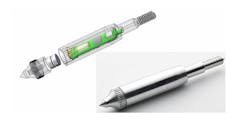Machine Control: Measuring Impact with Arrow-like Precision
Dec. 15, 2011
3 min read
With today's modern archery equipment, an arrow experiences over 1,000 g at launch and over 4,000 g at impact for each shot. Like industrial riveting machines and other metal-forming machine tools, arrows must be able to survive multiple strikes at such forces, and be proven to do so. Measurement and testing can be accomplished with a micro-electromechanical systems (MEMS) accelerometer.
Full Flight Technology (www.veolcitip.com) a Cambridge, Mass. developer of technology for ballistic measurement, is reportedly the first to use an arrow-mounted MEMS device to provide detailed information about arrow speed, flight dynamics and bow performance. It is "without a doubt the most sophisticated microelectronics technology ever applied to the field of archery," said company founder Bob Donahoe.
Full Flight's Velocitip Ballistic System is using Analog Devices Inc.'s iMEMS technology (www.analog.com/en/mems-sensors/products/index.html) in the form of the ADXL346 3-axis digital MEMS accelerometer, and demonstrating just what current MEMS technology can achieve.
The Velocitip Ballistic System is a tool for testing archery equipment performance. It includes a field point (arrow tip), battery pack, docking station, USB cable and PC software. The system employs the ADXL346 to continuously measure arrow drag in flight to provide downrange performance data. The ability to measure arrow drag means that, unlike a ballistic chronograph, the system does not require down-range equipment to measure arrow performance at target impact, says Donahoe. The archer simply threads the arrow tip to the arrow in a conventional manner and shoots at the target.
During product development, the ADXL346 (which weighs less than 6.5 grams) was housed in a 9-mm-diameter aluminum arrow tip and successfully tested for 100 cycles at 5,000 g. Coin cell batteries power the arrow tip for a minimum of 100 shots. Providing high 13-bit resolution measurement at up to ±16 g, the ADXL346 also features an integrated memory-management system with a 32-level FIFO (first-in, first-out) buffer to store ballistics data.
Because the MEMS device allows so much useful information to be precisely recorded, arrow and machine tool designers can more quickly and easily identify factors most important to improving performance. Donahoe says the accelerometer is "an essential enabling technology" because of its ability to survive repeated hi-g shock, its small package and "the perfect combination of precision measurement, low power, rugged construction and light weight."
According to ADI application engineer Harvey Weinberg, ADI's iMEMs accelerometers have already been applied to industrial and consumer applications including machine health monitors, washing machine load balancers, and neuromuscular stimulators that help injured people walk.
Analog Devices has created a portfolio of high performance sensors (www.analog.com/library/analogDialogue) that combine MEMS technology with signal conditioning and signal conversion technology. They include iMEMS accelerometers and gyroscopes as well as iSensor intelligent sensors and inertial measurement units (IMUs), and iMEMS analog and digital output microphone integrated circuits.
Full Flight Technology (www.veolcitip.com) a Cambridge, Mass. developer of technology for ballistic measurement, is reportedly the first to use an arrow-mounted MEMS device to provide detailed information about arrow speed, flight dynamics and bow performance. It is "without a doubt the most sophisticated microelectronics technology ever applied to the field of archery," said company founder Bob Donahoe.
Full Flight's Velocitip Ballistic System is using Analog Devices Inc.'s iMEMS technology (www.analog.com/en/mems-sensors/products/index.html) in the form of the ADXL346 3-axis digital MEMS accelerometer, and demonstrating just what current MEMS technology can achieve.
The Velocitip Ballistic System is a tool for testing archery equipment performance. It includes a field point (arrow tip), battery pack, docking station, USB cable and PC software. The system employs the ADXL346 to continuously measure arrow drag in flight to provide downrange performance data. The ability to measure arrow drag means that, unlike a ballistic chronograph, the system does not require down-range equipment to measure arrow performance at target impact, says Donahoe. The archer simply threads the arrow tip to the arrow in a conventional manner and shoots at the target.
During product development, the ADXL346 (which weighs less than 6.5 grams) was housed in a 9-mm-diameter aluminum arrow tip and successfully tested for 100 cycles at 5,000 g. Coin cell batteries power the arrow tip for a minimum of 100 shots. Providing high 13-bit resolution measurement at up to ±16 g, the ADXL346 also features an integrated memory-management system with a 32-level FIFO (first-in, first-out) buffer to store ballistics data.
Because the MEMS device allows so much useful information to be precisely recorded, arrow and machine tool designers can more quickly and easily identify factors most important to improving performance. Donahoe says the accelerometer is "an essential enabling technology" because of its ability to survive repeated hi-g shock, its small package and "the perfect combination of precision measurement, low power, rugged construction and light weight."
According to ADI application engineer Harvey Weinberg, ADI's iMEMs accelerometers have already been applied to industrial and consumer applications including machine health monitors, washing machine load balancers, and neuromuscular stimulators that help injured people walk.
Analog Devices has created a portfolio of high performance sensors (www.analog.com/library/analogDialogue) that combine MEMS technology with signal conditioning and signal conversion technology. They include iMEMS accelerometers and gyroscopes as well as iSensor intelligent sensors and inertial measurement units (IMUs), and iMEMS analog and digital output microphone integrated circuits.
About the Author
Renee Bassett
Managing Editor
Sign up for our eNewsletters
Get the latest news and updates

Leaders relevant to this article:
